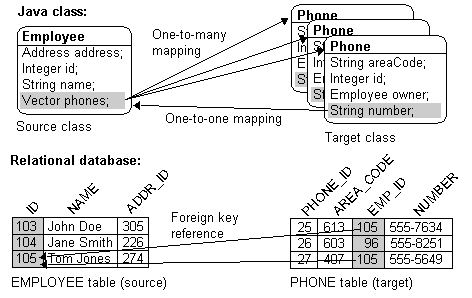
One-to-many mappings are used to represent the relationship between a single source object and a collection of target objects. They are a good example of something that is simple to implement in Java using a Vector (or other collection types) of target objects, but difficult to implement using relational databases.
In a Java Vector, the owner references its parts. In a relational database, the parts reference their owner. Relational databases use this implementation to make querying more efficient.
The purpose of creating this one-to-one mapping in the target is so that the foreign key information can be written when the target object is saved. Alternatives to the one-to-one mapping back reference include:
Example 5-7 One-to-Many Mapping
One-to-many mappings must put the foreign key in the target table, rather than the source table. The target class should also implement a one-to-one mapping back to the source object, as illustrated in the following figure.
Figure 5-16 One-to-Many Relationships

Copyright © 1997, 2004, Oracle. All rights reserved.